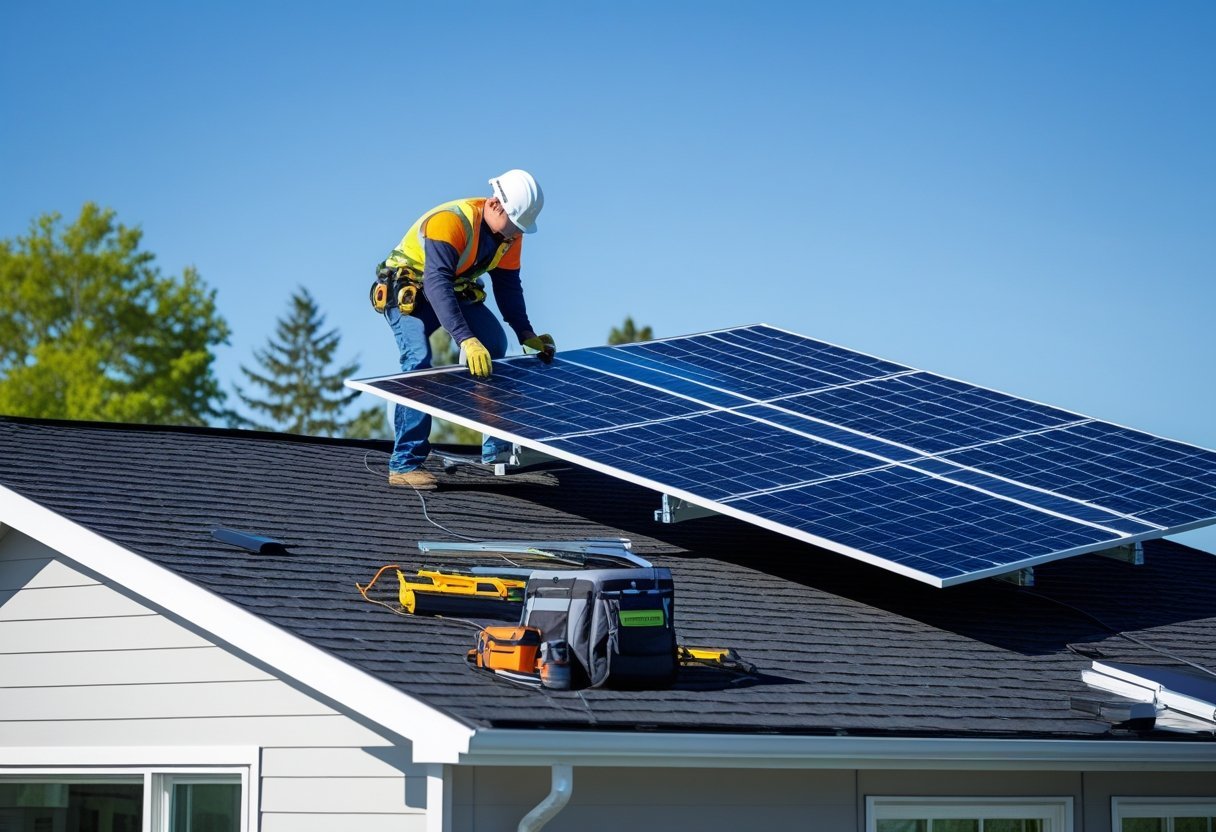The 7 Factors to Consider Before Installing Solar Panels on Your Roof
Installing solar panels can significantly reduce energy costs and increase property value. However, not every roof is suited for solar installation. The 7 factors to consider include roof condition, sunlight exposure, local regulations, system costs, energy needs, available incentives, and installation company reputation.
Assessing Roof Suitability
Before installing solar panels, homeowners must carefully review factors related to their roof’s condition, position, and potential obstacles.
Evaluating Roof Age and Condition
The age and condition of a roof are critical factors for solar panel installation. Roofs older than 15-20 years may require repairs or replacement before adding panels. Installing panels on a damaged or prematurely aged roof can lead to costly removal and reinstallation later.
Homeowners in Indianapolis should consider consulting Roof Repair Contractors in Indianapolis to inspect and assess roof integrity. A professional evaluation will determine if necessary repairs or reinforcements can sustain the added weight and attachment of solar panels.
Determining Roof Orientation and Angle
Optimal solar panel performance depends on roof orientation and tilt angle. South-facing roofs receive the most sunlight in the northern hemisphere, making them ideal for solar power. East- and west-facing roofs can still be viable but generally produce less energy.
The roof pitch should ideally be between 15° and 40° to maximize sunlight absorption. Steeper or flatter roofs may require specialized mounting hardware, which can increase installation complexity and costs.
Identifying Shading Issues
Shading significantly reduces solar panel efficiency. Trees, chimneys, antennae, or nearby buildings that cast shadows on panels can lower energy output by 10% or more.
A thorough examination of shading patterns during different times of day and seasons is necessary. Tools like sun path charts or smartphone apps help identify shading problems.
If shading is unavoidable, alternative mounting locations or panel types with better partial-shade tolerance might be considered. Roof Repair Contractors in Indianapolis can assist with trimming trees or advising on possible shading solutions.
Calculating Solar Potential and Energy Needs
Understanding your current energy use and how much sunlight your roof receives helps determine the right size and type of solar system. Accurately estimating these factors ensures efficiency and cost-effectiveness.
Analyzing Household Energy Consumption
A thorough review of past electricity bills is essential. Look at the total kilowatt-hours (kWh) used monthly and annually to identify patterns and spikes. This data shows how much energy the household needs from the solar system.
Breaking down consumption by appliance or area, such as heating, cooling, or lighting, provides insight into energy priorities. This helps in deciding whether to invest in more solar capacity or energy-saving upgrades.
Estimating Solar Output
Solar output depends mainly on the location’s sun exposure and the roof’s tilt and orientation. South-facing roofs in the northern hemisphere usually generate the most electricity.
Calculating potential output involves multiplying average daily sunlight hours by the panel’s efficiency and roof area available. Local weather patterns and shading from trees or buildings must be factored in to avoid overestimation.
Solar output estimates help size the system to meet energy needs without unnecessary overspending. Tools like the National Renewable Energy Laboratory’s PVWatts Calculator provide reliable local solar irradiance data.
Considering Seasonal Variations
Solar energy production fluctuates with the seasons. In winter, shorter days and lower sun angles reduce output, while summer offers longer, stronger sunlight hours.
Accounting for these changes is vital for ensuring consistent energy supply year-round. Households should plan for backup or supplementary energy during low-production months.
Adjustments may include sizing the system to cover winter energy needs or incorporating energy storage solutions. This balance prevents gaps between consumption and generation through the year.
Understanding Installation Logistics
Proper planning is essential to avoid delays and extra costs. Attention to legal requirements, installer qualifications, and potential roof improvements ensures a smoother solar panel installation.
Navigating Local Building Codes and Permits
Compliance with local building codes is mandatory before installing solar panels. These codes define safety standards, electrical requirements, and structural support limits.
Applying for permits usually involves submitting detailed plans to your city’s building department. In Indianapolis, the process requires checking with local authorities on specific forms and timelines.
Selecting Qualified Installers
Choosing experienced installers reduces risks related to poor workmanship or code violations. Certified companies often hold credentials like NABCEP certification, which is a common industry standard.
In Indianapolis, homeowners can consult trusted roofing and solar installation firms. Recommendations from Roof Repair Contractors in Indianapolis can provide reliable leads.
Installers should provide clear contracts outlining costs, warranties, and timelines. A thorough review of past projects and customer feedback helps ensure the company’s competence.
Evaluating Financial Incentives and Long-Term Impact
Financial benefits and ongoing costs significantly affect the decision to install solar panels. Incentives can lower upfront expenses, while long-term factors like payback period and maintenance impact overall savings.
Reviewing Incentives and Rebates
Many governments and utilities offer incentives such as tax credits, rebates, or grants to reduce installation costs. In the U.S., the federal Investment Tax Credit (ITC) allows a 30% deduction of the total system cost from federal taxes. Some states and local programs provide additional rebates, which vary widely by location.
Eligibility criteria and application deadlines are crucial. Incentives often require proof of purchase and installation from certified contractors.
Analyzing Payback Period and ROI
The payback period calculates how long it takes to recover solar panel costs through energy savings. This depends on factors like installation cost, electricity rates, system efficiency, and energy usage patterns.
Return on Investment (ROI) measures annual financial return relative to initial investment. Typically, payback ranges between 6 and 12 years, but it differs by region and system size. A shorter payback period means faster savings.
Assessing Ongoing Maintenance Requirements
Solar panels generally require minimal maintenance, but regular cleaning and inspections improve performance. Dust, debris, and shading can reduce efficiency by up to 15%.
Inverter replacement every 10-15 years and periodic wiring checks are common. Maintenance costs typically remain low but should be factored into long-term budgets.
A clear maintenance plan ensures consistent energy production and protects investment value over time.







